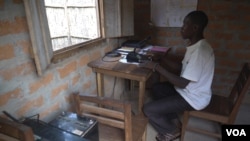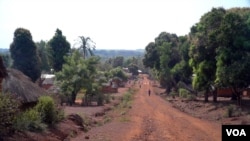Two decades after the Lord’s Resistance Army began terrorizing civilians in northern Uganda, the LRA boasts just a fraction of its former strength, about 100 to 150 fighters active in parts of central Africa.
However, the communities most at risk of attack have little protection in remote lawless regions of the Central African Republic and the Democratic Republic of the Congo (DRC).
In the village of Fenzane in southeastern C.A.R., for example, there are no government police officers, no army, and no United Nations troops. What they do have are regular attacks by bandits and armed groups like the Lord’s Resistance Army. Two people were killed in the village in an attack on Tuesday, just days after VOA visited.
Wearing a weathered jacket inside a thatched hut, 46-year-old Jeane Nakanda said she and the other residents in the area “feel abandoned by the government.”
“Even though we’re just 10 kilometers from the town center,” she said. “The government doesn’t think of us.”
Remote region
There also has been minimal economic development in this rural remote part of the country. They’re cut off – out of reach of cellphone networks.
But a $15-million project funded by USAID has found another way for communities to communicate and prepare for attacks – an early warning network of high-frequency and FM radios.
“The community was regrouped and closed off in itself,” said Yvon Brice Congo, who works on the radio project for Catholic Relief Services, “And so the community didn’t go from there, didn’t circulate between the villages. And they were deprived of essential foods, the elements essential for the life and all.”
Congo and his colleagues facilitated the creation of organized community protection committees in 32 communities in C.A.R., and another 62 in the DRC. Catholic Relief Services brought VOA to the area to show how it works.
Residents keep an eye on the movements of armed groups. They bring the information to the village chief who passes it onto the radio operator. The security information is shared via a solar-powered radio network operated by community volunteers.
“Before the project, the communities were very isolated,” Fenzane’s radio operator, Judical Mgbatissoungue, said inside of a small brick building with just enough room for a desk, a chair and his radio.
“In the past, the enemy came and we were surprised by that," said Mgbatissoungue. "Now it’s more difficult for them. We can prepare ourselves and be ready for the attack."
Protection plans
When info gets broadcast about armed groups nearby, the communities execute their non-violent protection plans.
“The community has already identified the spots in the village where the women and children go to the hiding spot,” said Jean Modest Oumboyo, Fenzane’s village chief. “The men go and survey the village to make sure everything is okay.”
Residents also keep their belongings and food in different spots in the town so they wouldn’t lose everything in a raid.
In the nearby larger town of Zemio, Jean Paul Kpiboroano helps to get the security information out more broadly to the area over FM radio airwaves. It’s distributed publicly only after it’s been verified by multiple sources.
“Attention, attention. Alert warning, alert warning,” he says over the radio waves, using local Central African languages when sharing critical information.
Kpiboroano said the LRA has been weakened and splintered over the past few years.
“In the bush, it’s not just the LRA who create the insecurity,” said Kpiboroano, the Berassa FM radio station director. “There are many forces of bandits who are found in the bush. If the LRA is defeated, the community protection plan designed by the project will survive forever. It’s not just for the LRA. It’s for us.”
Taking ownership
This early warning network has reached nearly 300,000 people in isolated communities of C.A.R. and D.R.C. With no other protection available, these communities can rely only on themselves.
“So much of it is the process of taking ownership and taking on the responsibility that is a transformation often from what happens in a society, like here where there is a lot of manipulation by leadership sometimes and other actors here,” said Scott Campbell, CRS’s Central Africa regional director. “That has real implications for one’s self image … and the entire community.”
Meanwhile, the new Trump administration has questioned whether the U.S. government should bother hunting down Kony.
“In the very small, globalized world of today, what happens in Africa, Middle East, Latin America has direct implications for us in America and vice versa,” he said. “We are all one human family and the interconnectedness of the world today is such that you cannot close yourself off from the rest of the world.”








